 This article was published in the Biological Conservation journal in August 2019 and deals with the methods used to build the Conservation Evidence [1] database.
This article was published in the Biological Conservation journal in August 2019 and deals with the methods used to build the Conservation Evidence [1] database.
Abstract: Conservation researchers, practitioners and policy-makers could lead to dramatic gains in the effectiveness of conservation practice. However, several barriers can hinder this transfer including lack of time, inaccessibility of evidence, the real or perceived irrelevance of scientific research to practical questions, and the politically motivated spread of disinformation.
Conservation Evidence works to overcome these barriers by providing a freely-available database of summarized scientific evidence for the effects of conservation interventions on biodiversity. The methods used to build this database – a combination of discipline-wide literature searching and subject-wide evidence synthesis – have been developed over the last 15 years to address the challenges of synthesizing large volumes of evidence of varying quality and measured outcomes.
Here, we describe the methods to enhance understanding of the database and how it should be used. We discuss how the database can help to expand multi-directional information transfers between research, practice and policy, which should improve the implementation of evidence-based conservation and, ultimately, achieve better outcomes for biodiversity.
You can access it on the Tour du Valat web portal here [2].
Bibliographical reference: Sutherland W.J., Taylor N.G., MacFarlane D., Amano T., Christie A.P., Dicks L.V., Lemasson A.J., Littlewood N.A., Martin P.A., Ockendon N., Petrovan S.O., Robertson R.J., Rocha R., Shackelford G.E., Smith R.K., Tyler E.H.M., Wordley C.F.R. 2019. Building a tool to overcome barriers in research-implementation spaces: The Conservation Evidence database. Biological Conservation 238:108199. doi: 10.1016/j.biocon.2019.108199 [3]